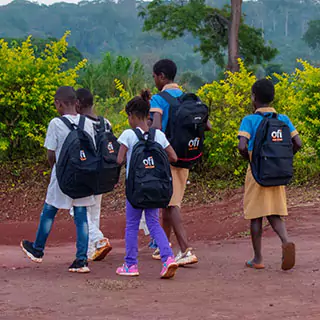1. Making sure there is a school nearby
In some cocoa communities, children have to walk for miles to get to the nearest school. To stop this from being a barrier, we help to build and renovate local schools.
In the Nyinahin district of Ghana, my team donated building materials and helped community Village Savings and Loans Associations (VSLAs) to save money to construct three new classrooms for high school students. By putting the power in the hands of the VSLA members, they could decide what type of facilities were most needed by their communities.
2. Providing the right equipment
Another stumbling block for children in cocoa farming communities attending school is the cost and availability of school supplies. Even something that seems as small as not having the right textbook can mean parents decide to keep their child at home instead.
In Cameroon, we gave 500 children the exercise books, school bags, and stationery they needed to confidently prepare for the new school year. Zene Veronique, Head Teacher of Ecole Primaire d'Emini in Ayos, Center Region of Cameroon, said, "I have watched children come to school with no books or no bag to protect their books. I am overwhelmed by this support. Just a few months back, we received benches and now today's learning materials. As the Head Teacher, I feel really honored".
We also offered 320 scholarships for academic excellence to children in Cameroon to cover their school fees and other educational expenses. And 20 children from lower socio-economic families were given grants.
3. Joining forces for change
We know that when it comes to helping children into education and tackling child labor, there is only so much one organization can do alone. That's why we pool our collective knowledge and resources into multi-stakeholder partnerships to accelerate our impact.
In Côte d'Ivoire, we are a part of CLEF, a coalition dedicated to enhancing access to and the quality of education in cocoa-growing regions by constructing school infrastructure, training teachers, and engaging parents in their children's learning. Led by the Ivorian Government in collaboration with 16 cocoa and chocolate companies, and philanthropic foundations, we aim to impact the lives of over 4 million children by 2027. So far, 145,000 children have participated in CLEF activities since Jan 2021 across 1,015 schools in the Lôh-Djiboua and Nawa regions.
And in Ghana, we're partnering with Mars and NGO Lead for Ghana to further its mission to improve the quality of education in underserved communities and keep children in school for longer.

